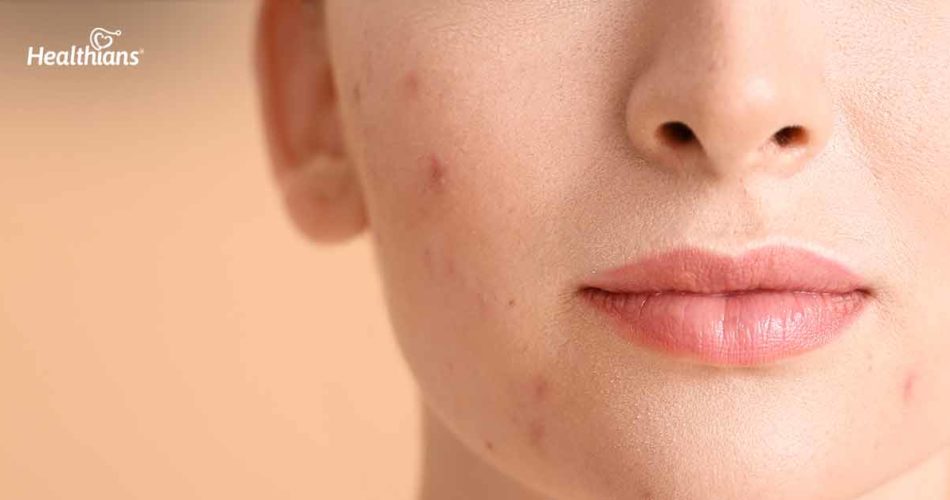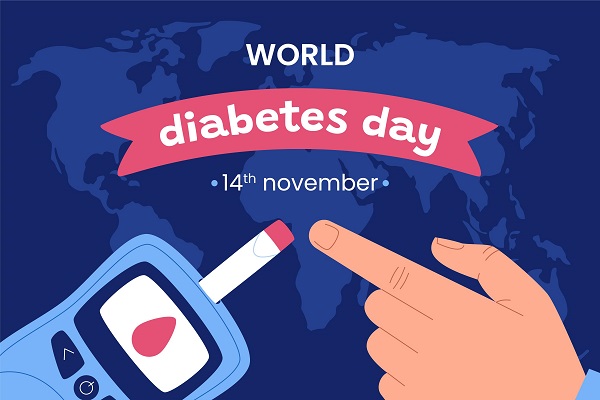Contributed by: Healthians Team
In one word acne is such a pain! Let’s begin with an understanding of what exactly acne is and how it occurs.
What is acne?
Acne, also known as acne vulgaris, is basically a skin condition that develops due to the clogging of hair follicles. The skin pores get clogged with oil, dust, or dead skin cells, which may lead to blackheads, whiteheads, red bumps on the skin, or pus-filled pimples.
Acne usually appears on the face, forehead, chest, upper back, and shoulders.
Different types of acne
The most common acne lesions are whiteheads and blackheads, also known as comedones.
- Whiteheads or closed comedones – small and under the surface of the skin
- Blackheads or open comedones- black-coloured and visible on the surface.
Inflammatory acne lesions are more likely to cause scars, which include-
- Papules (raised lesions)
- Pustules (raised lesions with pus)
- Cysts (nodules filled with pus or fluid)
Acne is most common among teenagers, however, adults also tend to get acne during their 30s, 40s, or even 50s. Pimples are the worst or most embarrassing thing you all get especially when you hit puberty.
As it’s truly said- “Adolescence is just one big walking pimple”
In fact, there are some myths and misconceptions about acne, such as-
Myth #1: Acne is caused by a poor diet
Fact: As yet, research has not found any foods that cause acne.
Myth #2: Squeezing blackheads, and whiteheads are the best way to get rid of acne
No, in fact doing this can actually make your symptoms worse and leave you with a scar.
Myth #3: Sexual activity can influence acne’–
Fact is, sexual activity or masturbation has literally nothing to do anything with acne.
Myth #4: Acne is infectious
No, acne is non-contagious and can not pass to another person.
Causes of acne
Acne is caused when tiny holes in the skin, known as hair follicles, become blocked.
Androgens are the sex hormones, which rise especially during puberty, thus leading to the enlargement of the sebaceous glands and the production of more oil and sebum than required. Excessive sebum blocks the hair follicles or pores and leads to the formation of acne or pimple.
Still, there are other multiple factors also that can flare up acne, such as-
- Medications– Certain medicines including steroids, brain disorders-related medicines, anti-epileptic medicines, etc.
- Some cosmetic products– Since acne-prone skin is very sensitive, it is suggested to use dermatologically tested products, especially which are non-comedogenic so that they don’t clog the skin pores.
- Smoking– Can also contribute to acne, especially in the elderly.
- Genetics– Acne has a tendency to run in families. If either of your parents is acne-prone, then it can make your skin also acne-prone.
- Diet– According to a 2021 review, certain foods or diets may have an effect on acne. Although, so far, research has found that no food can causes acne. But yes, according to some nutritionists there are certain foods that have a high glycemic index (GI) or sugar content, that can worsen your acne.
Food with high GI such as white rice, white bread, pasta, sugar etc, increases blood sugar levels more quickly. It further causes blood to release insulin-like growth factor-1 hormone.
This hormone increases sebum production when it is produced in large amounts, which can lead to the risk of acne and inflammation.
Hormones– Teenage acne is known to be triggered in boys and girls, due to increased levels of a hormone called androgens, during puberty. It enlarges or over activates the sebaceous gland and produces much more sebum than required, which ultimately leads to acne.
Hormonal changes during midlife, particularly in women, can lead to breakouts too.
Acne in women– Women are more likely to have acne as compared to men. At certain times, women can have hormonal imbalance during certain conditions like periods, pregnancy or menopause, PCOS (polycystic ovary syndrome), etc. which can cause acne.
Signs and symptoms of acne
- Whiteheads (closed plugged pores)
- Blackheads (open plugged pores)
- Papules (raised lesions)
- Pimples (pustules), which are papules with pus at their tips
- Large, solid, painful lumps under the skin (nodules)
- Painful, pus-filled lumps under the skin (cystic lesions)
How to treat acne?
Depending upon the particular factors like the condition’s severity, type of acne, or your age, the dermatologist may prescribe you particular medications either oral or topical.
Topical medications include
Antibiotics and retinoids- Dermatologists may prescribe topical or oral antibiotics (like erythromycin or tetracycline) and retinoids (like tretinoin or adapalene), to treat acne. Because topical antibiotics alone are usually not recommended.
The doctor may start with a low effective dose, because a high dose and prolonged treatment may cause adverse effects also.
In the initial phase of the treatment, the doctor might suggest using both a retinoid and an antibiotic, with the antibiotic applied in the morning and the retinoid in the evening.
Oral contraceptive- Hormonal therapies or the combined oral contraceptive pill can also help to control acne in women by suppressing the overactive gland.
Azelaic acid and salicylic acid– Along with antibacterial properties, azelaic acid can also be used to manage discolouration that occurs with some types of acne.
Dapsone– It is prescribed for inflammatory acne lesions, especially in women with acne.
Topical anti-androgen– Clascoterone is topical anti-androgen medicine, which belongs to a new class of treatment that targets the hormone that causes an outbreak.
Note: Remember to visit a dermatologist to ascertain the condition’s severity, before getting on a regimen. DO NOT SELF-MEDICATE.
Oral medications include
Oral antibiotics- Antibiotics work by killing excess skin bacteria and reducing redness and inflammation. It is generally recommended for long-term treatment. Take what the doctor prescribes for as long as it is prescribed. Do not stop the treatment mid-way on your own, even if you see improvement in symptoms. Complete the full course of antibiotic treatment.
Examples of oral antibiotics may include tetracycline, minocycline, doxycycline, etc. But, refrain from self-medication. The doctor will prescribe the appropriate antibiotic after a proper skin diagnosis.
Isotretinoin- It works by reducing the oil or sebum secretion from the sebaceous gland and thus restricts inflammation or redness and reduces the clogged hair follicles.
Home remedies for acne
Nowadays people are spending thousands and taking expensive treatments for acne. But you can still manage mild acne by just implementing simple home remedies. Here are a few!
Aloe vera
Aloe vera is rich in antioxidants, salicylic acid, and sulfur. According to research, applying aloe vera can help lessen acne.
How to use
You can directly scrape out the gel from the aloe vera plant with the help of a spoon and can directly apply it to the skin as a moisturizer.
Green tea
Apart from sipping green tea which has its own benefits of being an antioxidant, it can also be applied to the skin to take care of mild acne.
How to use-
Allow the brewed green tea to cool, and then apply it with a cotton swab on the skin, Let it stay for some time, and then rinse it off with water.
Turmeric facial mask
Turmeric is known to be one of the most effective and traditionally used home remedies when it comes to beautiful skin. But did you know, it can treat and prevent acne and scarring as well?
How to use-
You can make a turmeric facial mask and add a number of other ingredients like almond oil, honey, curd or chickpea flour, etc. as per your choice or convenience.
Add a sufficient amount of water to make it into a paste, apply it for 10 to 15 minutes, and then rinse with the cold water.
Cucumber face mask
Cucumber has a soothing effect on the skin and aids in reducing inflammation.
How to use
You can make a paste by blending one small cucumber and 1 cup of oatmeal. Apply it for at least 30 minutes and then wash it off with water.
Egg white mask
As per experts, eggs have lysozyme content, which is known to kill acne-causing bacteria, thus making eggs a great ‘at-home acne treatment’.
How to use-
Separate the egg white part from the yolk, apply it with a cotton swab, let it stay for 10-15 minutes, and then rinse it off.
Final thoughts
Acne treatment is a long process, and it may take a few weeks to several weeks to heal. So you have to have patience and follow the instructions as suggested by the doctor. Along with acne treatment, a good skincare routine, and proper hydration is needed.
“Here is a tip for ongoing prescription acne treatment- don’t use other treatments or home remedies., otherwise, they could worsen the acne condition.”
Moreover, you should also frequently opt for preventive health screening. It provides you with vital insights into your health, allowing you to take necessary measures to improve it.




